Microsoft Surface 2 Review
by Anand Lal Shimpi on October 21, 2013 12:00 AM EST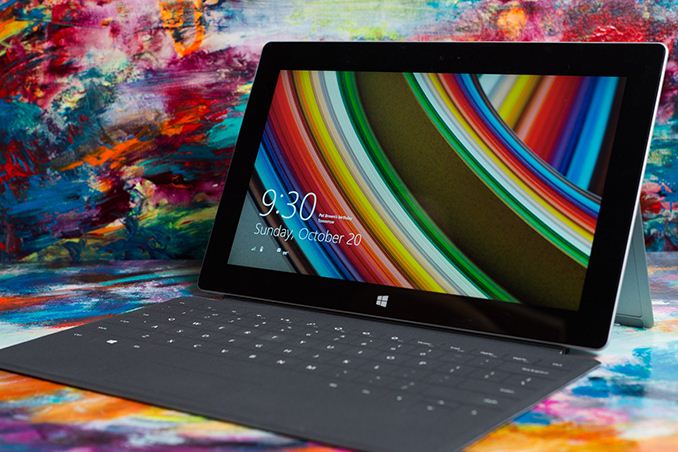
A year ago Microsoft first threw its hat into the tablet race with a new brand, a new OS and a completely new strategy. To make a challenging situation even more difficult, Microsoft chose to go after the traditional tablet market with a device that was neither a tablet nor a notebook.
I was relatively pleased with both Surface devices that launched last year. Surface RT had potential, but it was too slow, needed a price adjustment and of course needed more maturity on the OS side. Surface Pro on the other hand needed to be thinner, needed Haswell and related, it needed better battery life.
With its new commitment to being a devices & services company, Microsoft now joins the ranks of Apple and Google in shipping platforms with annual updates to hardware and software. Last week we saw the software side of the story, with a free update to Windows 8.1. It wasn’t too long ago that Microsoft was charging hundreds of dollars for new OS revisions, but with Apple and Google redefining what users come to expect from both cost and frequency of OS updates, Microsoft had to change.
Today we get the second half of the story. Microsoft’s partners have already announced their Windows 8.1 launch devices, now it’s time for Microsoft.
I’ll start with Surface 2, which sees the largest number of physical changes compared to its predecessor. It’s still built using the same injection molded magnesium manufacturing process (VaporMg, pronounced vapor mag), but moves to a 2-piece VaporMg design similar to Surface Pro. There’s the VaporMg tub and the kickstand.
The look and feel of the device see substantial updates. The finish of Surface 2 is now a light silver. Not only does the new finish not pick up grease/fingerprints like the previous black finish, but it also has a slightly more textured feel to it. Staring at Surface 2’s display head on you get a little bit of a silver border around the display, a nice touch. Surface 2’s construction feels every bit as solid and expensive as its predecessor. Both devices remain the absolute best built Windows tablets/notebooks on the market.
Curiously enough both Surface 2 and Surface Pro 2 ditch the Windows 8 logo on the back of the kickstand in favor of a Surface logo. The devices in general continue to be devoid of excess branding. Both have a capacitive Windows button up front, the aforementioned Surface logo around back and some branding on their respective chargers. There are no stickers to remove, and no COA labels to worry about. It may be years later than we’d hoped, but Microsoft finally gets the beauty of clean aesthetics.
The overall dimensions of Surface 2 don’t change much compared to its predecessor. We’re still dealing with the same 10.6-inch display size, although it sees an update to a 1080p panel with improved color accuracy. The panel size determines the overall device footprint, which explains why that doesn’t change this round. Thickness goes down a small amount from 0.37-inches to 0.35. The reduction is very subtle but helps contribute to the device feeling more right in hand.
Weight improves slightly if you compare Surface 2 to Surface RT. While the latter weighed in at 1.5 lbs, Microsoft lists Surface 2 as weighing less than 1.49 lbs. The somewhat vague spec is designed to take into account variations in manufacturing. Microsoft encouraged me to weigh my Surface 2 review sample, which came in at 1.45 lbs compared to a flat 1.50 lbs for Surface RT. It’s a small difference, but a definite step in the right direction. If the rumors of a lighter iPad 5 are true however, I do wonder if Microsoft should’ve been a bit more aggressive on the weight reduction front this round.
Just as before, Microsoft stresses the importance of looking at weight distribution not just overall weight specifications. Truth be told, Surface 2 doesn’t feel as heavy as the iPad despite having very similar weight specs.
A big part of the Surface story is the device’s integrated kickstand. The best way to talk about the improvements to the kickstand in Surface 2 (and Surface Pro 2) is to quote what I said about the previous design:
“The more I use Surface (Pro and RT) the more I feel that Microsoft needs to pursue something a bit more flexible than the fixed 26-degree kickstand. The biggest issue by far is in-lap use with one of the keyboard covers attached. Depending on your seating position, the 26-degree angle that the kickstand opens at might be too small. Mechanically I don’t know the right solution for Microsoft but I do feel like for the kickstand to realize its true potential, it needs to be able to open and hold at multiple angles. It doesn’t necessarily need to have support for infinite angles, maybe even a few would work, but I do believe it’s necessary going forward.”
Well, wouldn’t you know, Microsoft listened. Surface 2 and Surface Pro 2 both feature a new, 2-stage kickstand. You still get the same solid action, same sound and even the same 24-degree opening angle, but now there’s a second stop in the kickstand’s travel at 40-degrees. The 2-stage design almost completely addresses my issues with the first generation of Surface tablets. While the 24-degree stop is perfect for desk use, the 40-degree stop is ideal for in-lap use. The second stop keeps me from having to strain my neck looking down at the display when I’m typing in cramped quarters (e.g. having to type out this review in the back of a car heading to an airport).
Moving between stops on the new kickstand feels natural, and the new kickstand feels every bit as robust as its predecessor.
I don’t know that Microsoft has perfected the design though. I could still use another stop (or two). Perhaps one at 15-degrees for the on-chest use case if I’m laying down with the tablet on my chest watching a movie. A real issue created by the 40-degree stop is now I need even more leg/thigh/lap-space to support the device. Since there’s no support to hold the display up until you get to the kickstand, you need to make sure that the kickstand has a place to rest when open at its widest angle. I don’t know the right mechanical solution to this concern, but I still feel like Microsoft has some more work ahead of it on the kickstand front.
Behind the kickstand is a repositioned microSD card slot. It’s now further away from the kickstand hinge.
The ports/buttons around the edges of Surface 2 haven’t really changed compared to Surface RT. On the left you’ll find volume up/down buttons (which are appreciably clickier compared to my Surface RT review sample), a headphone jack and one of two speaker ports. On the top right there’s a power/lock button. On the right side you’ll find the other speaker port, micro HDMI output and a USB 3.0 port (new for Surface 2, RT only supported USB 2.0). All of the Surface devices retain the same custom, magnetic power connector as before.
Along the bottom there’s a slightly updated accessory connector and channel for accepting Surface’s famed keyboard covers, as well as new accessories this round. All first generation Surface accessories are supported.
Both front and rear facing cameras get a big upgrade with Surface 2. Surface RT shipped with two 1.2MP cameras, while Surface 2 moves to a 3.5MP front facing camera and a 5MP rear facing camera.
Internally, the upgrades are even more substantial. NVIDIA’s Tegra 3 is out of the picture, replaced by a far faster Tegra 4 SoC. That’s four ARM Cortex A15 cores running at up to 1.7GHz (1.9GHz with only one core active), as well as a fifth power saver core that actually sees some use this time (more on this later).
WiFi remains dual-band 2-stream 802.11n on both Surface 2 and Surface Pro 2, although whatever peak performance issues plagued me on Surface RT seem to be resolved (I could hit 120Mbps max transfers over 5GHz 802.11n).
The tablet still ships with 2GB of memory, but now leverages a 64-bit wide memory interface. On the storage side the options are still 32GB or 64GB of eMMC.
| Microsoft Surface 2/RT Comparison | ||||||||
| Surface 2 | Surface RT | |||||||
| Dimensions | 10.81 x 6.79 x 0.35" | 10.81 x 6.77 x 0.37" | ||||||
| Display | 10.6-inch 1920 x 1080 w/ Improved Color Accuracy | 10.6-inch 1366 x 768 PLS | ||||||
| Weight | Less than 1.49 lbs | 1.5 lbs | ||||||
| Processor | NVIDIA Tegra 4 1.7GHz | NVIDIA Tegra 3 | ||||||
| Connectivity | 802.11n WiFi | 802.11n WiFi | ||||||
| Camera | 3.5MP front facing, 5MP rear facing | 1.2MP front facing, 1.2MP rear facing | ||||||
| Memory | 2GB | 2GB | ||||||
| Storage | 32GB or 64GB eMMC | 32GB or 64GB | ||||||
| Battery | 31.5 Wh | 31.5 Wh | ||||||
| Starting Price | $449 | $349 | ||||||
Battery capacity is still 31.5Wh and Surface 2 still ships with a 24W charger. Surface 2 will draw 10W at the wall while charging, the over-specced adapter is designed to be able to power the system at full load without impacting charge times.
On the software front, Surface 2 ships with Windows RT 8.1 and a full copy of Office 2013 RT Home & Student Edition. Pricing starts at $449 for a 32GB model, or $549 for the 64GB version. Touch and Type covers continue to be sold separately at $119 and $129, respectively.


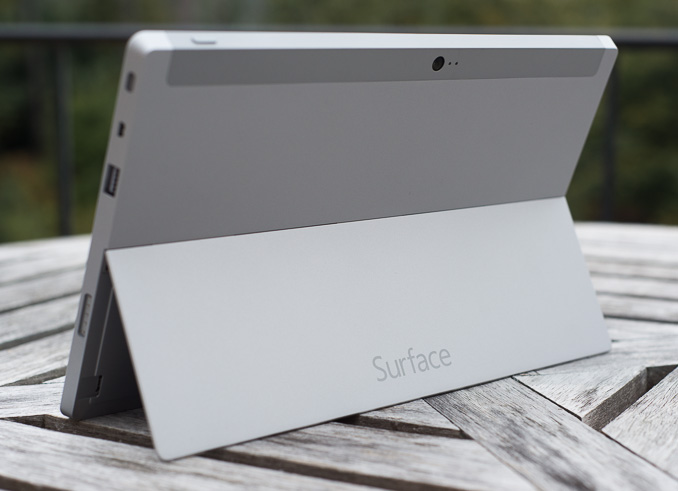
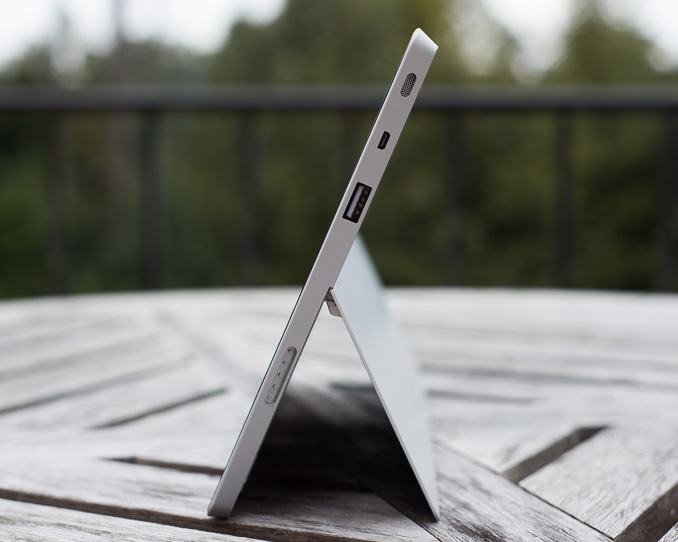
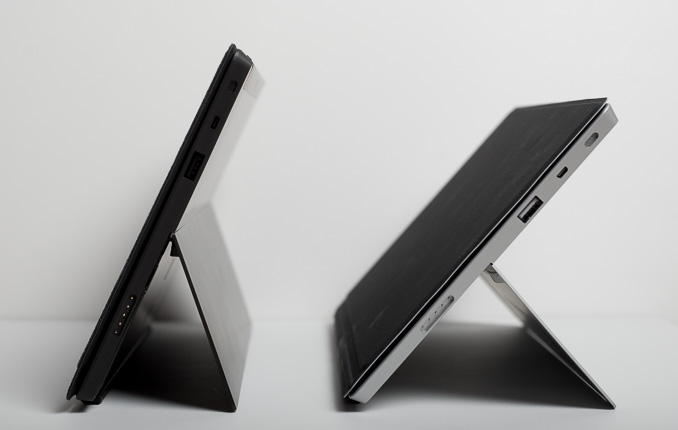
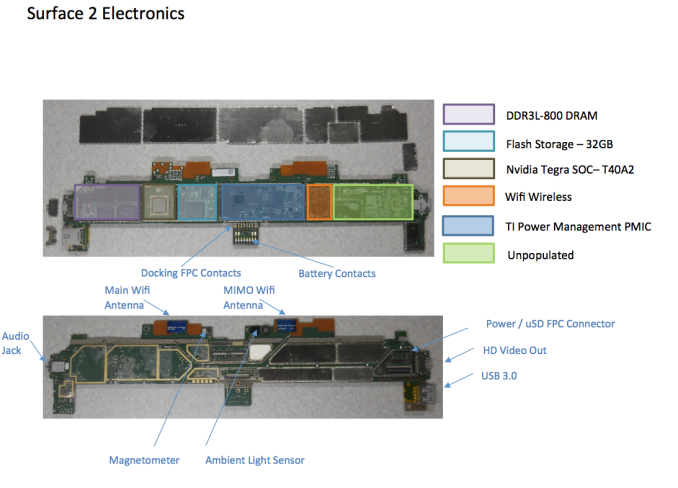








139 Comments
View All Comments
Daniel Egger - Monday, October 21, 2013 - link
That's actually a big sucker. While some managed to compile desktop applications that can be used after a jailbreak I'd absolutely second the notion that this is something that needs proper Microsoft support, even if just in the form of proper compilation support with a hard signing requirement to prevent abuse.kyuu - Monday, October 21, 2013 - link
What exactly are you unable to do versus an Android or iOS tab? Keep in mind WinRT has a fully featured web browser that can actually run flash, and any missing app probably has a fully functional website alternative.IUU - Monday, October 21, 2013 - link
"Why we should even care?" We shouldn't actually, if current solutions were better than full windows, but they are not.It may be hard for a lot to swallow, but full windows is in reality orders of magnitude more useful and sophisticated than the pathetic and overestimated apps of these "ecosystems". Even an ugly x86 virus is much more of a program than the overhyped android or peaches and oranges apps, that you may have to pay for as well, while in x86 you are freely and painlessly infected.
Mobile is useful but not the most important in home computing. Trying to give it false significance, you get carried away by vain analyses about the mechanics of the kickstand, the premium feeling and the aesthetics of the user interface; this is a regress because you get excited by things that were difficult to do 10 years ago. Instead of getting excited for the next REALLY BIG APP, that would require 10s of gigabytes and several teraflops to run, you get excited by things so basic they ve been inforporated in oses long ago. So, sorry that I can't share your fascination. Surface is a good tablet, as the ipad and the droids are, very good for basic functions, nothing more nothing less.
I would suggest Microsoft come out of the hypnosis about the post pc era and concentrate on really interesting things, like how we could use more powerful devices than today's desktops.
Gambit2K - Monday, October 21, 2013 - link
I missed parts like if miracast is available for surface 2, if it is how does it work, how much battery does it drain etc.And didn't I read that twitter has launched an official app for RT about 1-2 months ago.
Steinegal - Monday, October 21, 2013 - link
Surface 2 does support Miracast, but I haven't seen any tests of it yet.And twitter is available in the store :)
UsernameAlreadyExists - Monday, October 21, 2013 - link
"Google’s Octane test is obviously best optimized for Chrome, and here we see solid performance although clearly behind the latest from Apple and Intel." Something wrong with the graph / this sentence, or am I reading the graph incorrectly?UsernameAlreadyExists - Monday, October 21, 2013 - link
Ah, the new stuff is missing from the graph.kyuu - Monday, October 21, 2013 - link
There's something wrong with the conclusion, since the Surface 2 clearly beats the iPad 4 in the Google Octane benchmark.Anand Lal Shimpi - Monday, October 21, 2013 - link
er fixed, thanks!JB_Gator - Monday, October 21, 2013 - link
I agree that the app situation is lacking but this isn't a huge issue for me anymore. Maybe I'm an atypical user, but I prefer light gaming in the phone context, along with to-do lists and other light/quick tasks. Also, most of the apps I'd be looking for are usually necessary due to lack of flash support in the browser.For example: Would a Spotify app look a little cleaner? Sure. But I can listen to playlists through the website but not the app anyway (mobile apps require premium). I can't do this on my Nexus or iPad. A lot of video sites would require apps to if it weren't for this (ESPN, HBO, etc.), but not only can I watch them on the Surface, but if I wanted to, I can stream them to my TV (through xbox) out of the box with a few clicks.
I was with you until you suggested it should be $399 with a type cover. That would be ludicrously cheap. The iPad, which is it's closest competitor (for better or for worse) is $499 with no cover. Also, Apple doesn't offer keyboards on its smart covers (yet?).
At its current price of $50 cheaper than the iPad, with additional benefits (MS Office, USB, microSD, microHDMI-out for extended desktop, split-screen multitasking) and some tradeoffs (apps) it is a great deal already.
I feel like even matching the iPad at $499 with a touch cover would be shockingly cheap, especially for new hardware of this quality. (Also, way more reasonable/likely).